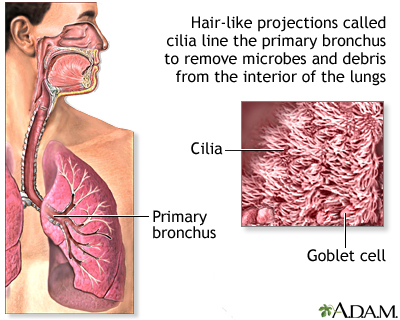Aging changes in the lungs
The lungs have two main functions. One is to get oxygen from the air into the body. The other is to remove carbon dioxide from the body. Your body needs oxygen to work properly. Carbon dioxide is a gas your body produces when it uses oxygen.
During breathing, air enters and exits the lungs. When you breathe in (inhale), air flows through the airways into the lungs. The airways are made of stretchy tissue. Bands of muscle and other support tissue wrap around each airway to help keep them open.
Air keeps flowing into the lungs until it fills tiny air sacs called alveoli. Blood circulates around these air sacs through tiny blood vessels called capillaries. Oxygen crosses into the bloodstream at the place where the blood vessels and air sacs meet. This is also where carbon dioxide crosses from the bloodstream into the lungs to be breathed out (exhaled).
AGING CHANGES IN YOUR BODY AND THEIR EFFECTS ON THE LUNGS
Changes to the bones and muscles of the chest and spine:
- Bones become thinner and change shape. This can change the shape of your ribcage. As a result, your ribcage may not expand and contract as well during breathing.
- The muscle that supports your breathing, the diaphragm, becomes weakened. This weakness may prevent you from breathing enough air in or out.
These changes in your bones and muscles may lower the oxygen level in your body. Also, less carbon dioxide may be removed from your body. Symptoms such as tiredness and shortness of breath can result.
Changes to lung tissue:
- Muscles and other tissues that are near your airways may lose their ability to keep the airways completely open. This causes the airways to close easily.
- Aging also causes the air sacs to lose their shape and become baggy.
These changes in lung tissue can allow air to get trapped in your lungs. Too little oxygen may enter your blood vessels and less carbon dioxide may be removed. This makes it hard to breathe.
Changes to the nervous system:
- The part of the brain that controls breathing may lose some of its function, weakening the automatic breathing functions. When this happens, your lungs are not able to get enough oxygen. Not enough carbon dioxide may leave the lungs. Breathing may get more difficult.
- Nerves in your airways that trigger coughing become less sensitive. Large amounts of particles like smoke or germs may collect in the lungs and may be hard to cough up.
Changes to the immune system:
- Your immune system can get weaker. This means your body is less able to fight lung infections and other diseases.
- Your lungs are also less able to recover after exposure to smoke or other harmful particles.
COMMON PROBLEMS
As a result of these changes, older people are at increased risk for:
- Lung infections, such as pneumonia and bronchitis
- Shortness of breath
- Low oxygen level
- Abnormal breathing patterns, resulting in problems such as sleep apnea (episodes of stopped breathing during sleep)
PREVENTION
To decrease the effects of aging on the lungs:
- Do not smoke. Avoid exposure to cigarette smoke. Smoking and smoke exposure harm the lungs and speeds up lung aging.
- Do physical exercise to improve lung function.
- Get up and move. Lying in bed or sitting for long periods allows mucus to collect in the lungs. This puts you at risk of lung infections. This is especially true right after surgery or when you are ill.
OTHER CHANGES RELATED TO AGING
As you grow older, you will have other changes, including:
- In organs, tissues, and cells
- In the bones, muscles, and joints
- In the heart and blood vessels
- In vital signs

The bronchus in the lungs are lined with hair-like projections called cilia that move microbes and debris up and out of the airways. Scattered throughout the cilia are goblet cells that secrete mucus which helps protect the lining of the bronchus and trap microorganisms.

Lung tissue atrophies and is not as efficient with age.
References
Davies GA, Bolton CE. Age-related changes in the respiratory system. In: Fillit HM, Rockwood K, Young J, eds. Brocklehurst's Textbook of Geriatric Medicine and Gerontology. 8th ed. Philadelphia, PA: Elsevier; 2017:chap 17.
George G, Ramirez MI, Roman J. Lung mesenchyme. In: Broaddus VC, Ernst JD, King TE, et al, eds. Murray & Nadel's Textbook of Respiratory Medicine. 7th ed. Philadelphia, PA: Elsevier; 2022:chap 5.
Meuleman J, Kallas HE. Geriatrics. In: Harward MP, ed. Medical Secrets. 6th ed. Philadelphia, PA: Elsevier; 2019:chap 18.
Walston JD. Common clinical sequelae of aging. In: Goldman L, Cooney KA, eds. Goldman-Cecil Medicine. 27th ed. Philadelphia, PA: Elsevier; 2024:chap 24.
Version Info
Last reviewed on: 7/15/2024
Reviewed by: Frank D. Brodkey, MD, FCCM, Associate Professor, Section of Pulmonary and Critical Care Medicine, University of Wisconsin School of Medicine and Public Health, Madison, WI. Also reviewed by David C. Dugdale, MD, Medical Director, Brenda Conaway, Editorial Director, and the A.D.A.M. Editorial team.
